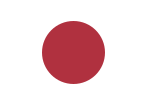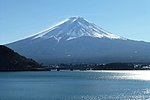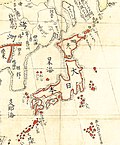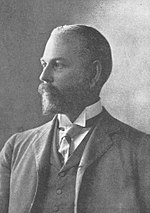The Japanese term shinbutsu bunri (神仏分離) indicates the separation of Shinto from Buddhism, introduced after the Meiji Restoration which separated Shinto...
14 KB (1,601 words) - 17:23, 24 June 2024
Shinto shrine (section Shinbutsu bunri)
separation of kami and foreign Buddhas (shinbutsu bunri) with the Kami and Buddhas Separation Order (神仏判然令, Shinbutsu Hanzenrei). This event triggered the...
82 KB (9,508 words) - 14:58, 9 September 2024
Shinbutsu-shūgō (神仏習合, "syncretism of kami and buddhas"), also called Shinbutsu-konkō (神仏混淆, "jumbling up" or "contamination of kami and buddhas"), is...
24 KB (2,863 words) - 16:02, 15 September 2024
with persecution and a forced separation between Buddhism and Shinto (Shinbutsu bunri). As of 2022, around 70.8 million people, or about 67% of Japan's total...
98 KB (11,856 words) - 10:39, 27 September 2024
as Himeji Castle survived by luck. During the Meiji restoration's Shinbutsu bunri, tens of thousands of Japanese Buddhist religious idols and temples...
38 KB (4,531 words) - 12:19, 27 September 2024
consequences for Japanese culture as a whole. It should not be confused with shinbutsu bunri ("separation of kami and buddhas") or with haibutsu kishaku ("abolish...
9 KB (1,120 words) - 16:12, 19 April 2023
Jingū-ji (category Shinbutsu shūgō)
danka system (檀家制度, danka seido) participated in the movement. The shinbutsu bunri policy was also the direct cause of serious damage to important cultural...
14 KB (1,739 words) - 15:00, 4 August 2024
Asakusa Shrine (category Shinbutsu bunri)
Asakusa Shrine (浅草神社, Asakusa-jinja) is a Shinto shrine in the Asakusa district of Tokyo, Japan. Also known as Sanja-sama (Shrine of the Three gods), it...
6 KB (564 words) - 10:40, 13 April 2024
Buddhism. Shinbutsu shūgō (神仏習合) – The syncretism of Buddhism and local religious beliefs, the normal state of things before the shinbutsu bunri. Shinsen...
122 KB (14,002 words) - 12:37, 14 September 2024
("Palace of Suiten") in Tokyo. After the Japanese emperor issued the Shinbutsu bunri, the separation of Shinto and Buddhist practices as part of the Meiji...
33 KB (3,446 words) - 22:59, 2 September 2024
Japan together with Buddhism.. When the Japanese Empire enforced the Shinbutsu bunri, the official separation of Shinto shrines and Buddhist temples, shrines...
3 KB (329 words) - 09:03, 14 June 2023
Haibutsu kishaku (category Shinbutsu bunri)
Iconoclasm Koshintō Martyrs of Japan Persecution of Buddhists Shinbutsu bunri Shinbutsu kakuri Shinbutsu-shūgō State Shinto Tokugawa Nariaki USSR anti-religious...
10 KB (1,040 words) - 23:02, 25 September 2024
Japan together with Buddhism.. When the Japanese Empire enforced the Shinbutsu bunri, the official separation of Shinto shrines and Buddhist temples, shrines...
2 KB (162 words) - 09:03, 14 June 2023
to the Meiji period's policy of separation of Buddhism and Shinto (Shinbutsu bunri) of 1868. Before the Meiji Restoration it was common for a Buddhist...
50 KB (5,730 words) - 00:55, 20 September 2024
on road sides. Before the forced separation of Shinto and Buddhism (Shinbutsu bunri), it was not uncommon for a Buddhist temple to be built inside or next...
39 KB (4,278 words) - 00:43, 22 September 2024
suijaku Shinbutsu-shūgō Gongen Nenbutsu Death poem Zen garden Zazen Daimoku Sōhei Ikkō-ikki Butsudan Obon Kaichō Kanjin Senjafuda Danka system Shinbutsu bunri...
15 KB (2,091 words) - 17:26, 1 June 2024
indigenous Japanese spirit. Under attack by two policies of the day, shinbutsu bunri (Separation of Shinto Deities and Buddhas) and haibutsu kishaku (Eradication...
119 KB (13,242 words) - 23:44, 29 August 2024
concrete keep was built for Nagoya castle. During the Meiji restoration's Shinbutsu bunri, tens of thousands of Japanese Buddhist religious idols and temples...
140 KB (15,523 words) - 05:40, 22 September 2024
pressure on Japanese Zen during the Meiji Restoration to conform to Shinbutsu Bunri. Sweetman mentions: Wilhelm Halbfass (1988), India and Europe IXth...
77 KB (7,533 words) - 11:49, 29 September 2024
Domain. He anticipated the forcible division of kami and Buddhas (shinbutsu bunri) of 1868 ordering there the destruction of a thousand Buddhist temples...
7 KB (829 words) - 16:35, 23 April 2024
Restoration (1868), the state forced a separation of Shinto and Buddhism (shinbutsu bunri) and abolished the Chokusai Hōe (Imperial Rituals). The Shingon school...
92 KB (11,496 words) - 20:00, 26 September 2024
(神滝)) Before the forcible separation of kami and Buddhas of 1868 (shinbutsu bunri) a shintai could even be the statue of a Buddhist deity. Other shintai...
7 KB (824 words) - 17:52, 20 September 2024
rites until the Meiji period, when the government forbade with the shinbutsu bunri policy the mixing of Shinto and Buddhism. bodai – from the Pāli and...
43 KB (5,264 words) - 18:09, 5 May 2024
Okakura Kakuzō (category Shinbutsu bunri)
Okakura Kakuzō (岡倉 覚三, February 14, 1863 – September 2, 1913), also known as Okakura Tenshin (岡倉 天心), was a Japanese scholar and art critic who in the...
19 KB (2,215 words) - 15:58, 2 October 2024
anti-Buddhist violence, in particular that of the early Meiji period. See also shinbutsu bunri. haimyō (俳名) – a "haiku pen-name". It was common in the Edo period...
14 KB (1,962 words) - 13:05, 3 May 2024
suijaku Shinbutsu-shūgō Gongen Nenbutsu Death poem Zen garden Zazen Daimoku Sōhei Ikkō-ikki Butsudan Obon Kaichō Kanjin Senjafuda Danka system Shinbutsu bunri...
38 KB (4,471 words) - 22:00, 9 September 2024
the shogunate, this involved the separation of Shinto and Buddhism (shinbutsu bunri) and the associated destruction of various Buddhist temples and related...
66 KB (8,065 words) - 19:27, 30 September 2024
in the mid-1500s by Catholic missionaries". Haibutsu kishaku Shinbutsu bunri Shinbutsu kakuri Shimabara Rebellion Crypto-Christianity Hidden Christian...
8 KB (677 words) - 19:39, 22 August 2024
followed the official policy of separation of Shinto and Buddhism (shinbutsu bunri) many of the city temples were damaged. In other cases, because mixing...
62 KB (7,116 words) - 09:38, 20 September 2024
Ernest Fenollosa (category Shinbutsu bunri)
Ernest Francisco Fenollosa (February 18, 1853 – September 21, 1908) was an American art historian of Japanese art, professor of philosophy and political...
13 KB (1,432 words) - 22:00, 5 May 2024





























